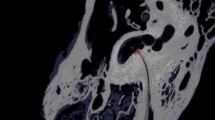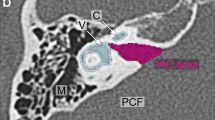Abstract
Our intention was to evaluate whether enlargement of the cochlear aqueduct could play a role in dysfunctions of the inner ear. There is little literature dealing with the question of cochlear aqueduct (CA) enlargement and results of reported radiological examinations are contradictory. Therefore, we decided to analyse 400 high-resolution CT-scans of the temporal bone to examine the diameter of the CA. We used scan-data from a 64-line multislice spiral-CT-scanner stored in our PACS-System. CA-enlargement was defined as a diameter of more than 1 mm in the whole otic capsule portion. A classification with four types of CA’s proposed by Migirov and Kronenberg in 2005 was applied. Statistical analysis of diameters, different CA-types and side asymmetry was performed. We did not find any CA exceeding 1 mm in diameter in the otic capsule portion, there is no evidence of CA-enlargement, not even in patients with inner ear malformation. A new aspect compared with published literature to date is that nearly in all cases CA was identified, but in different degrees. According to our findings, it seems to be very unlikely that CA-enlargement is a reason for pathologic inner ear condition as it is in case of large vestibular aqueduct.






Similar content being viewed by others
References
Swartz JD, Harnsberger HR (1998) The otic capsule and otodystrophies. In: Swartz JD, Harnsberger HR (eds) Imaging of the temporal bone, 3rd edn. Thieme New York, Stuttgart, pp 240–317
Tekdemir I, Aslan A, Ersoy M, Karahan ST, Tellioglu C (2000) A radiologic-anatomical comparative study of the cochlear aqueduct. Clin Radiol 55(4):288–291
Gopen Q, Rosowski JJ, Merchant SN (1997) Anatomy of the normal human cochlear aqueduct with functional implications. Hear Res 107(1–2):9–22
Galic M, Giebel W (1987) Scanning electron microscopy studies of the structure of tissue in the cochlear opening of the cochlear aqueduct. Laryngol Rhinol Otol 66(1):1
Allen GW (1987) Fluid flow in the cochlear aqueduct and cochlea-hydrodynamic considerations in perilymph fistula, stapes gusher, and secondary endolymphatic hydrops. Am J Otol 8(4):319–322
Walsted A, Salomon G, Thomsen J, Tos M (1991) Hearing decrease after loss of cerebrospinal fluid. A new hydrops model. Acta Otolaryngol 111(3):468–476
Sterkers O, Ferrary E, Amiel C (1988) Production of inner ear fluids. Physiol Rev 68(4):1083–1128
Jackler RK, Hwang PH (1993) Enlargement of the cochlear aqueduct: fact or fiction. Otolaryngol Head Neck Surg 109(1):14–25
Mukherji SK, Baggett HC, Alley J, Carrasco VH (1998) Enlarged cochlear aqueduct. Am J Neuroradiol 19(2):330–332
Bachor E, Byahatti S, Karmody CS (1997) The cochlear aqueduct in pediatric temporal bones. Eur Arch Otorhinolaryngol 254(Suppl 1):34–38
Migirov L, Kronenberg J (2005) Radiology of the cochlear aqueduct. Arch Otol Rhinol Laryngol 114(11):863–866
Oh AK, Ishiyama A, Baloh RW (2001) Vertigo and the enlarged vestibular aqueduct syndrome. J Neurol 248(11):971–974
Bachor E, Byahatti S, Karmody CS (1997) The cochlear aqueduct in pediatric temporal bones. Eur Arch Otorhinolaryngol 254(Suppl1):S34–S38
Bachor E, Byahatti S, Karmody CS (1999) New aspects in the histopathology of the cochlear aqueduct in children. Am J Otol 20(5):612–620
Zelikovich EI (2004) CT of the temporal bone in the study of the inner ear structures in detection of the causes of neurosensory hypoacusis. Vestn Otorinolaringol (6):25–31
Zhang SZ, Yang WY, Wu ZM (2006) Relationship between the external aperture and hearing loss in large vestibular aqueduct syndrome. Chin Med J 119(3):211–216
Camargo da Silva DP, Motovani JC, Oliveira DT, Fioravanti MP, Tamashiro IA (2008) The large vestibular aqueduct syndrome: a cause of neurosensry dysacusia. Pro Fono 20(2):133–135
Walsted A (2000) Effects of cerebrospinal fluid loss on hearing. Acta Otolaryngol Suppl 543:95–98
Pogodzinski MS, Shallop JK, Sprung J, Weingarten TN, Wong GY, McDonald TJ (2008) Hearing loss and cerebrospinal fluid pressure: case report and review of the Literature. Ear Nose Throat J 87(3):144–147
Papsin BC (2005) Cochlear implantation in children with anomalous cochleovestibular anatomy. Laryngoscope 115:1–26
Shim, Shin JE, Chung JW, Lee KS (2006) Inner ear anomalies in cochlear implantees: importance of radiologic measurements in the classification. Otol Neurotol 27(6):831–837
Conflict of interest
The authors declare that they have no conflicts of interest that influence their actions. The authors have no financial relationship to other organizations with effects on their work. There was no external sponsoring. Each author has participated sufficiently to take responsibility for the content.
Author information
Authors and Affiliations
Corresponding author
Rights and permissions
About this article
Cite this article
Stimmer, H. Enlargement of the cochlear aqueduct: does it exist?. Eur Arch Otorhinolaryngol 268, 1655–1661 (2011). https://doi.org/10.1007/s00405-011-1527-9
Received:
Accepted:
Published:
Issue Date:
DOI: https://doi.org/10.1007/s00405-011-1527-9




